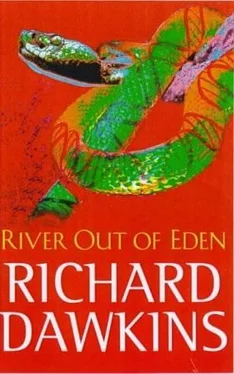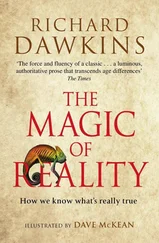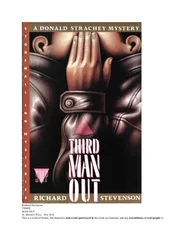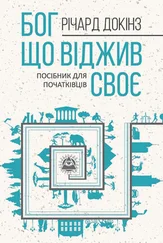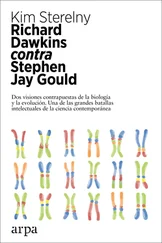Even in a digital telephone, the sounds entering the {14} mouthpiece and leaving the earpiece are still analog fluctuations in air pressure. It is the information traveling from exchange to exchange that is digital. Some kind of code has to be set up to translate analog values, microsecond by microsecond, into sequences of discrete pulses – digitally coded numbers. When you plead with your lover over the telephone, every nuance, every catch in the voice, every passionate sigh and yearning timbre is carried along the wire solely in the form of numbers. You can be moved to tears by numbers – provided they are encoded and decoded fast enough. Modern electronic switching gear is so fast that the line's time can be divided into slices, rather as a chess master may divide his time among twenty games in rotation. By this means, thousands of conversations can be slotted into the same telephone line, apparently simultaneously yet electronically segregated without interference. A trunk data line – many of them nowadays are not wires at all but radio beams, either transmitted directly from hilltop to hilltop or bounced off satellites – is a massive river of digits. But because of this ingenious electronic segregation, it is thousands of digital rivers, which share the same banks only in a superficial sense – like red squirrels and gray, who share the same trees but never intermingle their genes.
Back in the world of engineers, the deficiencies of analog signals don't matter too much, as long as they aren't copied repeatedly. A tape recording may have so little hiss on it that you hardly notice it – unless you amplify the sound, in which case you amplify the hiss and introduce some new noise too. But if you make a tape of the tape, then a tape of the tape of the tape, and so on and on, after a {15} hundred “generations” a horrible hiss will be all that remains. Something like this was a problem in the days when telephones were all analog. Any telephone signal fades over a long wire and has to be boosted – reampli-fied – every hundred miles or so. In analog days this was a bugbear, because each amplification stage increased the proportion of background hiss. Digital signals, too, need boosting. But, for the reason we've seen, the boosting does not introduce any error: things can be set up so that the information gets through perfectly, no matter how many boosting stations intervene. Hiss does not increase even over hundreds and hundreds of miles.
When I was a small child, my mother explained to me that our nerve cells are the telephone wires of the body. But are they analog or digital? The answer is that they are an interesting mixture of both. A nerve cell is not like an electric wire. It is a long thin tube along which waves of chemical change pass, like a trail of gunpowder fizzing along the ground – except that, unlike a trail of gunpowder, the nerve soon recovers and can fizz again after a short rest period. The absolute magnitude of the wave – the temperature of the gunpowder – may fluctuate as it races along the nerve, but this is irrelevant. The code ignores it. Either the chemical pulse is there or it is not, like two discrete voltage levels in a digital telephone. To this extent, the nervous system is digital. But nerve impulses are not dragooned into bytes: they don't assemble into discrete code numbers. Instead, the strength of the message (the loudness of the sound, the brightness of the light, maybe even the agony of the emotion) is encoded as the rate of impulses. Engineers know this as Pulse Frequency Modulation, and it {16} was popular with them before Pulse Code Modulation was adopted.
A pulse rate is an analog quantity, but the pulses themselves are digital: they are either there or they are not, with no half measures. And the nervous system reaps the same benefit from this as any digital system does. Because of the way nerve cells work, there is the equivalent of an amplifying booster, not every hundred miles but every millimeter – eight hundred boosting stations between the spinal cord and your fingertip. If the absolute height of the nerve impulse – the gunpowder wave – mattered, the message would be distorted beyond recognition over the length of a human arm, let alone a giraffe's neck. Each stage in the amplification would introduce more random error, like what happens when a tape recording is made of a tape recording eight hundred times over. Or when you Xerox a Xerox of a Xerox. After eight hundred photocopying “generations,” all that's left is a gray blur. Digital coding offers the only solution to the nerve cell's problem, and natural selection has duly adopted it. The same is true of genes.
Francis Crick and James Watson, the unravelers of the molecular structure of the gene, should, I believe be honored for as many centuries as Aristotle and Plato. Their Nobel Prizes were awarded “in physiology or medicine,” and this is right but almost trivial. To talk of continuous revolution is almost a contradiction in terms, yet not only medicine but our whole understanding of life will go on being revolutionized again and again as a direct result of the change in thinking that those two young men initiated in 1953. Genes themselves, and genetic disease, are only the tip of the iceberg. What is truly revolutionary about {17} molecular biology in the post-Watson-Crick era is that it has become digital.
After Watson and Crick, we know that genes themselves, within their minute internal structure, are long strings of pure digital information. What is more, they are truly digital, in the full and strong sense of computers and compact disks, not in the weak sense of the nervous system. The genetic code is not a binary code as in computers, nor an eight-level code as in some telephone systems, but a quaternary code, with four symbols. The machine code of the genes is uncannily computerlike. Apart from differences in jargon, the pages of a molecular-biology journal might be interchanged with those of a computer-engineering journal. Among many other consequences, this digital revolution at the very core of life has dealt the final, killing blow to vitalism – the belief that living material is deeply distinct from nonliving material. Up until 1953 it was still possible to believe that there was something fundamentally and irreducibly mysterious in living protoplasm. No longer. Even those philosophers who had been predisposed to a mechanistic view of life would not have dared hope for such total fulfillment of their wildest dreams.
The following science-fiction plot is feasible, given a technology that differs from today's only in being a little speeded up. Professor Jim Crickson has been kidnapped by an evil foreign power and forced to work in its biological-warfare labs. To save civilization it is vitally important that he should communicate some top-secret information to the outside world, but all normal channels of communication are denied him. Except one. The DNA code consists of sixty-four triplet “codons,” enough for a complete upper- and lower-case English {18} alphabet plus ten numerals, a space character and a full stop. Professor Crickson takes a virulent influenza virus off the laboratory shelf and engineers into its genome the complete text of his message to the outside world, in perfectly formed English sentences. He repeats his message over and over again in the engineered genome, adding an easily recognizable “flag” sequence – say, the first ten prime numbers. He then infects himself with the virus and sneezes in a room full of people. A wave of flu sweeps the world, and medical labs in distant lands set to work to sequence its genome in an attempt to design a vaccine. It soon becomes apparent that there is a strange repeated pattern in the genome. Alerted by the prime numbers – which cannot have arisen spontaneously – somebody tumbles to the idea of deploying code-breaking techniques. From there it would be short work to read the full English text of Professor Crickson's message, sneezed around the world.
Читать дальше
